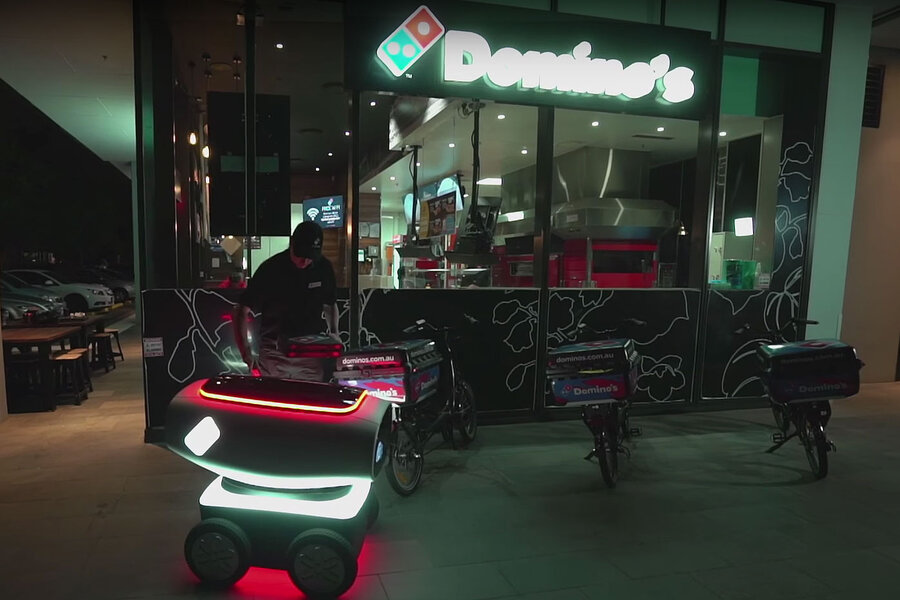Robo pizza delivery: Is automation putting low-wage workers at risk?
Loading...
The words "pizza delivery" could someday be spoken on doorsteps worldwide, not by a baseball-capped delivery worker making minimum wage, but instead by a fully automated robot.
Domino's Pizza in Australia announced Friday that new pizza-delivery robots, called Domino's Robotic Unit or DRU, can navigate neighborhoods and deliver pizza straight to customers, Asha Barbaschow reported for ZDNet.
It's been a big week for fast food automation overall. On Wednesday, Andy Puzder, CEO of fast-food chains Carl's Jr. and Hardee's, said that he wants fully automated kitchens in his restaurants. He said he was inspired by Eatsa, a new California restaurant selling cheap quinoa bowls at the touch of a button, Hayley Peterson reported for Business Insider. The Eatsa system hides the workers who cook the food behind a fully automated ordering process, and busy customers need not see or interact with Eatsa workers.
Fast food workers have become the face of the movement "Fight for $15" that for three years has gained ground in a push to increase the minimum wage. Puzder, an opponent of recent pushes to raise minimum wage, said automating the complex kitchens his restaurants use would be difficult but that political changes may encourage technological innovation.
"With government driving up the cost of labor, it's driving down the number of jobs," Mr. Puzder told Business Insider's Kate Taylor. "You're going to see automation not just in airports and grocery stores, but in restaurants."
Domino's CEO and Managing Director Don Meij said the new pizza droid was not aiming to fully eliminate delivery workers, which will still be needed in traffic or rural locations.
But in a rapidly changing, globalized economy, cost is always a factor in business decisions.
"If you're making labor more expensive, and automation less expensive — this is not rocket science," Puzder told Business Insider.
The restaurant industry is among the largest in terms of employing minimum wage workers. In New York alone, restaurants rely on over 400,000 such workers, putting it on par with the retail and care sectors, according to the Economic Policy Institute, a think tank that researches the impact of economic trends and policies on American workers. This institute advocates for increasing federal minimum wage as a means of ensuring decent quality of life to these workers.
"A parent who works full time and is paid the federal minimum wage does not currently earn enough through work to be above the poverty line," Economic Policy Institute David Cooper wrote in a recent EPI report.
The counter-argument is that dramatic, politically motivated wage increases force businesses to cut their workers' hours, or even their jobs, the Michael Saltsman of Employment Policies Institute, a research organization studying public policy and employment growth, wrote in an op-ed for the Orange County Register.
Using the California city of Oakland, which raised its minimum wage from $9 to $12.25 on March 2, 2015, as a case study, Mr. Saltsman described the effects of the well-intentioned wage increase a "costly gamble." He wrote that 10 Chinatown stores and restaurants closed after the minimum wage increased, a seafood restaurant laid off two workers, and three restaurants raised meal prices by 20 percent.
Innovations such as pizza-droids or automated burger flippers could complicate both arguments. Fast food chains are already demonstrating their ability to fund customized research for robots that distinguish them from their competition. The initial investment will be costly, but the public's excitement for such discoveries might pay the bills.
"[The Domino's Robotic Unit] highlights what can happen when disruptive thinking is fostered – it turns into a commercially viable and revolutionary product," Mr. Meij said when announcing the product, according to ZDNet. "The DRU prototype is only the first step in our research and development as we continue to develop a range of innovations set to revolutionize the entire pizza ordering experience."
Even the Domino's Robotic Unit is not nearly ready to hit the road, but robots like it could eventually offer fast food companies a high-tech alternative to costly political debate, and all at the touch of a button.








